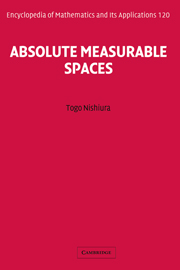Book contents
- Frontmatter
- Contents
- Preface
- Acknowledgements
- 1 The absolute property
- 2 The universally measurable property
- 3 The homeomorphism group of X
- 4 Real-valued functions
- 5 Hausdorff measure and dimension
- 6 Martin axiom
- Appendix A Preliminary material
- Appendix B Probability theoretic approach
- Appendix C Cantor spaces
- Appendix D Dimensions and measures
- Bibliography
- Notation index
- Author index
- Subject index
Preface
Published online by Cambridge University Press: 14 May 2010
- Frontmatter
- Contents
- Preface
- Acknowledgements
- 1 The absolute property
- 2 The universally measurable property
- 3 The homeomorphism group of X
- 4 Real-valued functions
- 5 Hausdorff measure and dimension
- 6 Martin axiom
- Appendix A Preliminary material
- Appendix B Probability theoretic approach
- Appendix C Cantor spaces
- Appendix D Dimensions and measures
- Bibliography
- Notation index
- Author index
- Subject index
Summary
This book is about absolute measurable spaces. What is an absolute measurable space and why study them?
To answer the first question, an absolute measurable space, simply put, is a separable metrizable space X with the property that every topological embedding of X into any separable metrizable space Y results in a set that is μ–measurable for every continuous, complete, finite Borel measure μ on Y. Of course, only Borel measures are considered since the topology of Y must play a role in the definition.
For an answer to the second question, observe that the notion of absolute measurable space is a topological one in the spirit of many other notions of “absolute” such as absolute Borel space, absolute Gδ space, absolute retract and many more. As the definition is topological, one is led to many topological questions about such spaces. Even more there are many possible geometric questions about such spaces upon assigning a metric to the space. Obviously, there is also a notion of “absolute null space”; these spaces are those absolute measurable spaces for which all topological copies have μ measure equal to 0. Absolute null spaces are often called “universal measure zero sets” and have been extensively studied. The same topological and geometric questions can be investigated for absolute null spaces. It is well–known that absolute Borel spaces are absolute measurable spaces. More generally, so are analytic and co–analytic spaces.
- Type
- Chapter
- Information
- Absolute Measurable Spaces , pp. ix - xiiPublisher: Cambridge University PressPrint publication year: 2008

